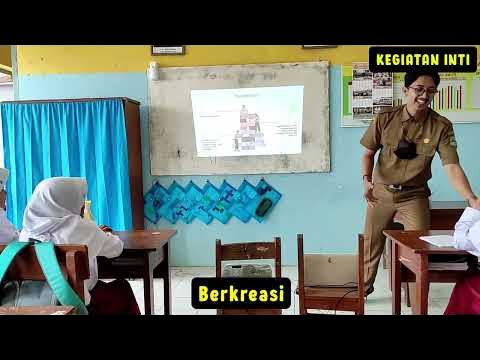Model Pembelajaran Kooperatif Tipe Team Assisted Individualization (TAI)
Summary
TLDRThis video discusses the Tipe GI (Type A) cooperative learning model, which integrates individual learning with group collaboration to accommodate students' diverse abilities. The model emphasizes forming heterogeneous groups based on factors like ability, gender, and ethnicity. Key components include placement tests, creative teaching methods, individual responsibilities, and regular assessments. By fostering teamwork and mutual support, students help each other grow academically. The approach ensures no student feels isolated, motivating them to achieve their best through both individual tasks and group success. The model encourages a comprehensive, structured learning environment that adapts to varying student needs.
Takeaways
- 😀 The GI Type cooperative learning model blends cooperative learning with individual instruction to cater to students' varying abilities.
- 😀 Students are grouped based on ability, gender, ethnicity, and other factors, ensuring diverse groups for learning.
- 😀 The model emphasizes peer support, where students help each other, ensuring that no student feels left behind.
- 😀 Group work is essential in this model, with each student contributing both individually and as part of their group.
- 😀 Placement tests are crucial for organizing students into appropriate groups based on their abilities (high, medium, low).
- 😀 Students with different abilities collaborate within their groups, sharing knowledge and helping each other succeed.
- 😀 The model integrates multiple forms of assessment, including placement tests, formative tests, and peer evaluations.
- 😀 Teachers tailor their teaching methods according to the ability levels of students, ensuring effective learning for all.
- 😀 A reward system motivates students, with groups that perform well receiving recognition and incentives.
- 😀 Regular assessments ensure that students progress and that remedial measures are provided to those who need them.
- 😀 The GI Type model is especially effective for subjects that require analytical thinking, such as mathematics and physics.
Q & A
What is the main focus of the cooperative learning model 'Tipe GI' discussed in the script?
-The main focus of the 'Tipe GI' model is to combine cooperative learning with individualized instruction, ensuring that students with different abilities can collaborate and progress at their own pace while also helping others in their group.
How are groups formed in the 'Tipe GI' cooperative learning model?
-Groups are formed based on several factors, including the students' abilities (high, medium, low), gender, ethnicity, or the type of school they attend. These groupings ensure diversity and support across different levels of student performance.
What role does motivation play in the 'Tipe GI' model?
-Motivation is crucial as it encourages students to collaborate and support one another. Even students with higher abilities are motivated to help those with lower abilities, fostering a sense of mutual achievement and reducing feelings of isolation.
What is the importance of placement tests in this model?
-Placement tests are important for dividing students into appropriate groups based on their abilities. This ensures that each group is balanced and that students can learn and contribute effectively according to their level.
How does the teacher adapt their teaching for different groups in the 'Tipe GI' model?
-Teachers adjust their teaching methods to cater to the different ability levels within the groups. For example, higher ability students might be taught more abstract concepts, while lower ability students might need more concrete, hands-on teaching methods.
What is the significance of collaborative work in the 'Tipe GI' model?
-Collaborative work allows students to learn from each other, especially when they face challenges. Those with higher abilities can help those with lower abilities, ensuring that everyone has the opportunity to succeed and progress.
How does individual responsibility fit into this cooperative learning model?
-While students work in groups, each individual is responsible for their own learning. They must complete individual tasks and assessments, contributing to the group’s overall success while ensuring personal progress.
What types of assessments are used in the 'Tipe GI' model?
-Assessments include pre-tests (placement tests), formative assessments (individual and group tasks), and regular tests to evaluate both individual and group performance. These tests help identify areas for improvement and track progress.
How do students provide feedback to one another in this model?
-Students engage in peer review and correction, where they check each other’s work. The feedback is tailored to the student's ability level, with higher ability students correcting the work of lower ability peers and vice versa.
What are the rewards and recognition mechanisms in the 'Tipe GI' model?
-Rewards are given to both individuals and groups based on their performance. Groups that perform well are acknowledged, and individuals receive stars or other forms of recognition for their efforts, motivating students to keep striving for success.
Outlines

This section is available to paid users only. Please upgrade to access this part.
Upgrade NowMindmap

This section is available to paid users only. Please upgrade to access this part.
Upgrade NowKeywords

This section is available to paid users only. Please upgrade to access this part.
Upgrade NowHighlights

This section is available to paid users only. Please upgrade to access this part.
Upgrade NowTranscripts

This section is available to paid users only. Please upgrade to access this part.
Upgrade NowBrowse More Related Video

Matakuliah: METODOLOGI PEMBELAJARAN - Teams Games Tournaments (TGT)

Model Pembelajaran Think Pair and Share - Andin Rizki Aulia

Model Pembelajaran Think Pair Share (TPS) Berbasis Sosial Media

Video Penerapan Model Pembelajaran TAI (Team Assisted Individualization) - Kelompok 5 Offering D

KONSEP PENDIDIKAN YANG MEMERDEKAKAN

Media Pembelajaran Yang Tepat Untuk Anak Berkebutuhan Khusus
5.0 / 5 (0 votes)